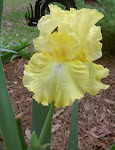 uilt my large quilts that I thought I'd show how I actually do quilt them. This is how my quilt lives while on my table being quilted. One of the "quilting theories" is that the sides should be rolled up neatly so the quilt can go into the machine more easily--or something like that. It never has worked for me--just didn't feel comfortable--so I use the "big pile' method. The whole thing just seems to move better and I don't the feel of a carpet hanging off the end of the table.
uilt my large quilts that I thought I'd show how I actually do quilt them. This is how my quilt lives while on my table being quilted. One of the "quilting theories" is that the sides should be rolled up neatly so the quilt can go into the machine more easily--or something like that. It never has worked for me--just didn't feel comfortable--so I use the "big pile' method. The whole thing just seems to move better and I don't the feel of a carpet hanging off the end of the table. Here you can see  me actually quilting. I ha
me actually quilting. I ha ve a large flat space for my quilt to rest on--two Horn sewing tables with back extensions; however, depending on what part of the quilt I'm quilting, I don't want the it to spread out too much because it will pull on the area where I'm working and could cause problems.
ve a large flat space for my quilt to rest on--two Horn sewing tables with back extensions; however, depending on what part of the quilt I'm quilting, I don't want the it to spread out too much because it will pull on the area where I'm working and could cause problems.
 me actually quilting. I ha
me actually quilting. I ha ve a large flat space for my quilt to rest on--two Horn sewing tables with back extensions; however, depending on what part of the quilt I'm quilting, I don't want the it to spread out too much because it will pull on the area where I'm working and could cause problems.
ve a large flat space for my quilt to rest on--two Horn sewing tables with back extensions; however, depending on what part of the quilt I'm quilting, I don't want the it to spread out too much because it will pull on the area where I'm working and could cause problems.And then I've inclu ded a couple of closeups to show what I do with
ded a couple of closeups to show what I do with  my hands while being surrounded by all that bunched-up fabric. The idea is to keep the area you're working on taut so you won't have any puckers on the front or the back. In the second picture, it's kind of difficult to see so you might want to click on it to enlarge it, but I have the quilt actually crimped together in my right hand so I can pull it where I want it to go a little more easily.
my hands while being surrounded by all that bunched-up fabric. The idea is to keep the area you're working on taut so you won't have any puckers on the front or the back. In the second picture, it's kind of difficult to see so you might want to click on it to enlarge it, but I have the quilt actually crimped together in my right hand so I can pull it where I want it to go a little more easily.
 ded a couple of closeups to show what I do with
ded a couple of closeups to show what I do with  my hands while being surrounded by all that bunched-up fabric. The idea is to keep the area you're working on taut so you won't have any puckers on the front or the back. In the second picture, it's kind of difficult to see so you might want to click on it to enlarge it, but I have the quilt actually crimped together in my right hand so I can pull it where I want it to go a little more easily.
my hands while being surrounded by all that bunched-up fabric. The idea is to keep the area you're working on taut so you won't have any puckers on the front or the back. In the second picture, it's kind of difficult to see so you might want to click on it to enlarge it, but I have the quilt actually crimped together in my right hand so I can pull it where I want it to go a little more easily.Well, this is what works for me. You can see that I have a light directly over my work. I have very good lighting in my studio--true color flourescents--but you just can't have to much light when you're quilting.









3 comments:
Judy thanks for sharing these photos with us. After seeing your quilts, I had also asked you how you did it. Just goes to prove that a picture is worth _______.
Joyce Greer
Judy - Do you ever do any marking on your quilts or just wing it? Could you share how you decide on/choose quilting designs? Thanks for the great pictures but I'll stick with my longarm! GRIN
Karen,the only marking I usually do on my quilts is when I want to do feathers. In that instance, I just draw the one curved line that marks the shape of feather. As for how I choose my designs, I just look at the quilt and think about what is suitable for that area. (And I've been known to pick out thousands and thousands of stitches when I later decided that it was a WRONG decision!) I try to keep in mind what Priscilla Hair said--that the design of the quilting should reflect the design of the quilt.
As to sticking with the longarm, I think you're right--we each should follow the path that is best for us and you seem to have done that. Good work!
Post a Comment